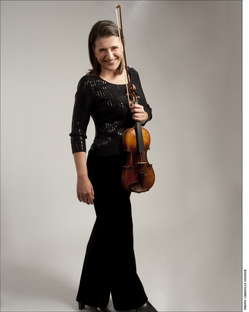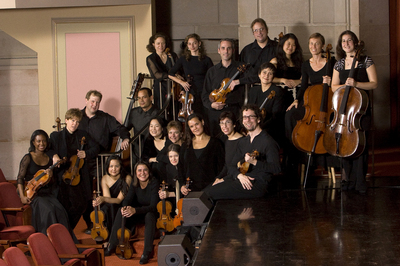Violinist Nadja Salerno-Sonnenberg finds new challenges as the leader of the band

Nadja Salerno-Sonnenberg
photo by Christian Steiner
We know her as an intense and dazzling soloist. But a little over two years ago, violinist Nadja Salerno-Sonnenberg took on a new role, one she hadn’t anticipated: music director. She’s now in her third season leading San Francisco’s New Century Chamber Orchestra, which makes a UMS debut Friday with Salerno-Sonnenberg as soloist and a presence in the “boss’s chair,” as she put it in a recent phone call.
It’s been an exciting partnership, she said, in a conversation that ranged from talk of her new assignment to the repertoire for the concert — arrangements of Wolf’s “Italian Serenade” and Bartok’s “Romanian Folk Dances,” Tchaikovsky’s “Serenade for Strings” and a piece that will put her front and center, Piazzolla’s “Cuatro estaciones portenas” (“Four seasons of Buenos Aires”), a complement to the Vivaldi and Glass “Seasons” UMS patrons enjoyed last fall.
Q. What drew you to this job? A. It was a call from a friend of a friend, who asked whether I had ever heard of the New Century Chamber Orchestra. We started talking about it, and my interest was piqued about the group, and I ended up going out as a guest.
Sitting as concert master and leading an orchestra from that seat, I had never ever done that before, never thought about doing it. If you’re a soloist and have branched out and done so many other things, the job description is different. But I love and miss playing in an orchestra. I have always missed that; even as a soloist, I’ll often ask if I can I sit in the back for the symphony after a concerto appearance.
My guest appearance with New Century was longer than the usual one. It was 10 or 12 days — enough to get to know people and soak up the experience. I have describe it in this way: I felt like I was infected; I couldn’t shake it.
PREVIEW
Nadja Salerno-Sonnenberg
- Who: Accomplished violinist, with the New Century Chamber Orchestra.
- What: Music of Wolf, Bartok, Piazzolla and Tchaikovsky.
- Where: Rackham Auditorium, 915 E. Washington St.
- When: Friday, 8 p.m.
- How much: $24-$50, UMS Ticket Office in the Michigan League, 734-764-2538, and online at ums.org.
Q. Did you have qualms about making a career shift like the one you’ve made? A. I knew they were looking for a new music director, and it was never anything I considered; it’s a huge time commitment and responsibility. But I knew that if this became a reality, I would find time for it.
Q. How much of your time are you spending with New Century? A. Every time I go out, it’s two, sometimes three weeks. There are other events, fundraisers and recordings, so it’s a good chunk of time every time I go out there. It’s a yearlong job.
Q. What are the challenges of this sort of role for you? A. It’ s vast and it’s very exciting. About 15 years ago, I started to branch out and play not just classical soloist repertoire, and I played with different kinds of people. One week it was Tchaikovsky with an orchestra, the violin concerto, the next week, totally different repertoire with the Assad brothers. You have to change, and change gears. I’ve been doing that for years already; that kind of metamorphosis not difficult. The challenge is that as a soloist a dotted eighth note is anything you want it to be. As a member of an orchestra, in that chair, a dotted eighth is a dotted eighth. It’s a discipline for me. It’s not the freedom I feel as a soloist, but yet I want this orchestra to sound like 19 soloists. That ‘s the challenge for me.

New Century Chamber Orchestra
photo by Jim Block
Q. How has the orchestra responded? A. You have to start with good ingredients, and they can play — they are good. What they needed was inspiration. After three seasons with them, the thing that is so extraordinary about me and the New Century, is that these two separate msucial forces, when they come together, the chemistry is quite amazing. What it is I can bring to a performance, and what they can bring, is very powerful. So is the trust that grows and grows and grows. On stage, as proud as I am of our recordings, you have to see it live — there is palpable joy, such risk-taking on stage. They will come with me. It’s like watching a high-wire act.
Q. A lot of the program you’re presenting here was not originally written for chamber orchestra … does it benefit from the change? A. I think that hearing a familiar tune in a different setting is, at the very least, interesting. I played the Bartok “Romanian Dances” as a kid. And the piece benefits from the different setting. The Piazzolla was originally written for his quartet. I have played it with the Assads, too, but this arrangement makes it symphonic; this piece is hormonal, I think that because of this particular arrangement, the piece really rises to another level. It’s an extraordinary work, and it demands every single musician to play like a soloist, sounds we weren’t taught when we were in school. The orchestra and soloist have to rise to the demands, and the audience, too.
The Wolf, if you’re a musician and you have played it, you know it’s a gnarly and tricky six-minute gem even in quartet form. It’s difficult, and to put that challenge on an orchestra is an aggressive decision. It says we’re going to come out and show you. And the Tchaikovsky — well, you may say, yeah, we know this piece; yah, we’ve heard it before. But you haven’t. I promise an extra added element.
This is the orchestra’s first tour with me, and I’m dying to show them off to the rest of the country. And it’s great for me, personally, to be back in Ann Arbor. It’s special to me. I’m a great Wolverine fan.

